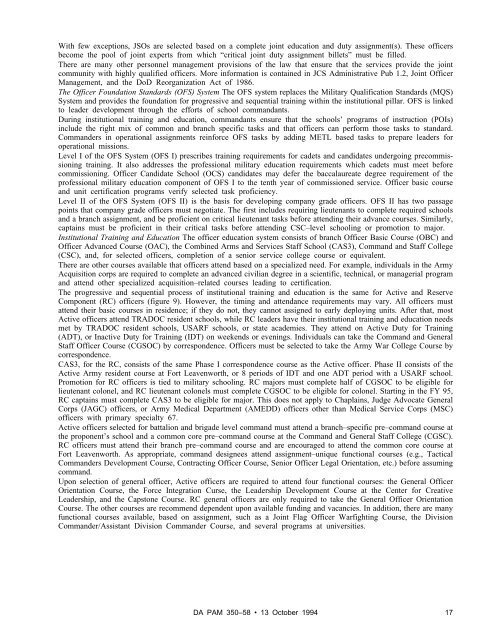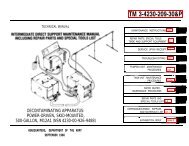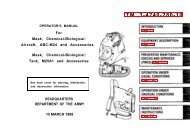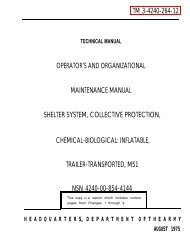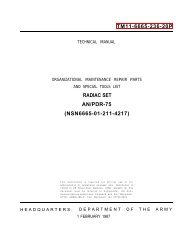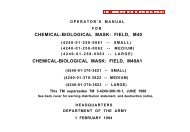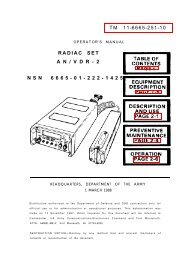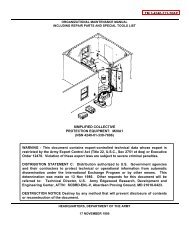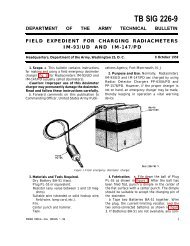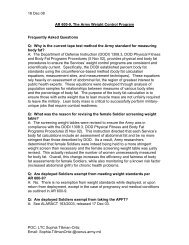LEADER DEVELOPMENT FOR AMERICA'S ARMY
LEADER DEVELOPMENT FOR AMERICA'S ARMY
LEADER DEVELOPMENT FOR AMERICA'S ARMY
Create successful ePaper yourself
Turn your PDF publications into a flip-book with our unique Google optimized e-Paper software.
With few exceptions, JSOs are selected based on a complete joint education and duty assignment(s). These officers<br />
become the pool of joint experts from which “critical joint duty assignment billets” must be filled.<br />
There are many other personnel management provisions of the law that ensure that the services provide the joint<br />
community with highly qualified officers. More information is contained in JCS Administrative Pub 1.2, Joint Officer<br />
Management, and the DoD Reorganization Act of 1986.<br />
The Officer Foundation Standards (OFS) System The OFS system replaces the Military Qualification Standards (MQS)<br />
System and provides the foundation for progressive and sequential training within the institutional pillar. OFS is linked<br />
to leader development through the efforts of school commandants.<br />
During institutional training and education, commandants ensure that the schools’ programs of instruction (POIs)<br />
include the right mix of common and branch specific tasks and that officers can perform those tasks to standard.<br />
Commanders in operational assignments reinforce OFS tasks by adding METL based tasks to prepare leaders for<br />
operational missions.<br />
Level I of the OFS System (OFS I) prescribes training requirements for cadets and candidates undergoing precommissioning<br />
training. It also addresses the professional military education requirements which cadets must meet before<br />
commissioning. Officer Candidate School (OCS) candidates may defer the baccalaureate degree requirement of the<br />
professional military education component of OFS I to the tenth year of commissioned service. Officer basic course<br />
and unit certification programs verify selected task proficiency.<br />
Level II of the OFS System (OFS II) is the basis for developing company grade officers. OFS II has two passage<br />
points that company grade officers must negotiate. The first includes requiring lieutenants to complete required schools<br />
and a branch assignment, and be proficient on critical lieutenant tasks before attending their advance courses. Similarly,<br />
captains must be proficient in their critical tasks before attending CSC–level schooling or promotion to major.<br />
Institutional Training and Education The officer education system consists of branch Officer Basic Course (OBC) and<br />
Officer Advanced Course (OAC), the Combined Arms and Services Staff School (CAS3), Command and Staff College<br />
(CSC), and, for selected officers, completion of a senior service college course or equivalent.<br />
There are other courses available that officers attend based on a specialized need. For example, individuals in the Army<br />
Acquisition corps are required to complete an advanced civilian degree in a scientific, technical, or managerial program<br />
and attend other specialized acquisition–related courses leading to certification.<br />
The progressive and sequential process of institutional training and education is the same for Active and Reserve<br />
Component (RC) officers (figure 9). However, the timing and attendance requirements may vary. All officers must<br />
attend their basic courses in residence; if they do not, they cannot assigned to early deploying units. After that, most<br />
Active officers attend TRADOC resident schools, while RC leaders have their institutional training and education needs<br />
met by TRADOC resident schools, USARF schools, or state academies. They attend on Active Duty for Training<br />
(ADT), or Inactive Duty for Training (IDT) on weekends or evenings. Individuals can take the Command and General<br />
Staff Officer Course (CGSOC) by correspondence. Officers must be selected to take the Army War College Course by<br />
correspondence.<br />
CAS3, for the RC, consists of the same Phase I correspondence course as the Active officer. Phase II consists of the<br />
Active Army resident course at Fort Leavenworth, or 8 periods of IDT and one ADT period with a USARF school.<br />
Promotion for RC officers is tied to military schooling. RC majors must complete half of CGSOC to be eligible for<br />
lieutenant colonel, and RC lieutenant colonels must complete CGSOC to be eligible for colonel. Starting in the FY 95,<br />
RC captains must complete CAS3 to be eligible for major. This does not apply to Chaplains, Judge Advocate General<br />
Corps (JAGC) officers, or Army Medical Department (AMEDD) officers other than Medical Service Corps (MSC)<br />
officers with primary specialty 67.<br />
Active officers selected for battalion and brigade level command must attend a branch–specific pre–command course at<br />
the proponent’s school and a common core pre–command course at the Command and General Staff College (CGSC).<br />
RC officers must attend their branch pre–command course and are encouraged to attend the common core course at<br />
Fort Leavenworth. As appropriate, command designees attend assignment–unique functional courses (e.g., Tactical<br />
Commanders Development Course, Contracting Officer Course, Senior Officer Legal Orientation, etc.) before assuming<br />
command.<br />
Upon selection of general officer, Active officers are required to attend four functional courses: the General Officer<br />
Orientation Course, the Force Integration Curse, the Leadership Development Course at the Center for Creative<br />
Leadership, and the Capstone Course. RC general officers are only required to take the General Officer Orientation<br />
Course. The other courses are recommend dependent upon available funding and vacancies. In addition, there are many<br />
functional courses available, based on assignment, such as a Joint Flag Officer Warfighting Course, the Division<br />
Commander/Assistant Division Commander Course, and several programs at universities.<br />
DA PAM 350–58 • 13 October 1994<br />
17


